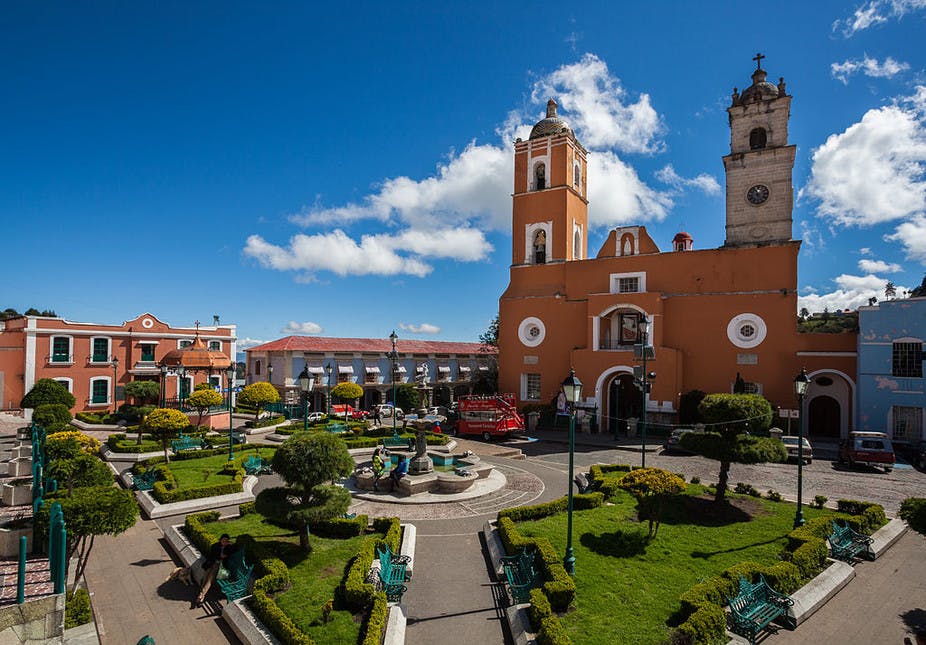Sitting at an altitude of 2,700 metres, Real del Monte is a pretty town in the Mexican state of Hidalgo. But with its architecture, heritage of silver mining and meat pasties, it is also a little slice of Cornwall, a region in the southwest of England.
The silver mines surrounding Real del Monte were the source of more than half the silver produced during the 300 years that Spain rule Mexico (1521–1821). By 1824, however, they were in bad condition, and were bought by a group of English investors.
To get the mines working again, the investors formed the Company of the Gentlemen Adventurers in the Mines of Real del Monte, and recruited more than 130 miners and engineers from Cornwall. When they arrived a year later in Veracruz, some never got any further, falling victim to an outbreak of yellow fever. It took the others more than a year to reach Real del Monte, hauling their Cornish steam engines through marshes and rainforests with the help of donkeys. The famous engines were used to drain the water in the Cornish mines and would do the same job in Mexico.
The mines in Pachuca and Real del Monte (officially Mineral del Monte since 1869) had long been flooded and badly needed modernising. These Cornish technicians and their machines were able to fulfil both requirements.
The first wave of Cornish miners and engineers were followed by many others. In the 1830s and 1840s, up to 350 were working in the surrounding mines. They were recruited through family networks with most coming from the towns of Camborne, Redruth and Gwennap. While some eventually returned to England, others chose to remain in Mexico.
Francis Rule left Camborne in 1853 at age 17 and made his fortune in the Mexican mines. Known as “El Rey de la Plata” (the silver king), he was a benefactor of the neighbouring city of Pachuca, where he had an imposing clock-tower built that still stands in the main square. At the beginning of the 20th century Rule also contributed to the construction of Pachuca’s Methodist church, where worshippers are still numerous among the local population.
A vibrant culture
Today the industrial and cultural heritage inherited from these Cornish families is significant and much appreciated in the region. Many local residents are proud to have English surnames such as Rule or Ludlow, and Cornish pasties are considered their “national” dish. To produce them, the men and women who crossed the Atlantic to work in the silver mines brought with them turnips, then unknown in Mexico. In the little streets of Pachuca and Real del Monte the “paste” shops are now numerous.
In 2009 the first Internacional Festival de Paste was held in Real del Monte, and two years later the Museo del Paste – where visitors are invited to cook and taste the little meat pies – opened its doors. The Duchess of Cornwall and her husband, Prince Charles, visited in 2014.

Other historical sites testify to both the industrial advances and architectural contributions of members of this English community. At the Acosta mine, which closed in 1985, the buildings’ architecture is in the style typical of Cornish mines. The engine house and the high chimneys offer an unexpected industrial landscape in this green and mountainous region.

In the mining towns, houses built during the 19th century, with their sloping roofs, recall those of the southwestern tip of England. Yet the Casa Rule – formerly the Rule family’s house and now Pachuca’s town hall – is in the French Renaissance style. Constructed by the successful and wealthy “Francisco” Rule, it was designed to impress.

On a hill overlooking Real del Monte, in what used to be the English quarter, is the magnificent Pantéo Inglès, or English cemetery. It was established on land offered by one of the managers of the mines, Thomas Straffon, who was the first Briton to arrive with his wife and their children. Of the 755 tombs, all oriented toward England, the oldest dates to 1834. The plot of John Vial is more recent. This young Englishman chose to leave Real del Monte to fight with his compatriots during World War I and died in the Somme in 1916.

The English also introduced football to Mexico. The first game was played in 1900 by the Cornish miners who founded the Pachuca Athletic Club, Mexico’s first football club. In the 1930s Alfred C. Crowle, who emigrated from Cornwall to work in the mines, became the manager of the Mexican national football team.
This rich and unusual legacy is sustained and promoted by the Cornish Mexican Cultural Society, founded in 2008. Redruth and Real del Monte became sister cities the same year, and trade between the two regions is growing. Thanks to its quirky heritage, Mexico’s little Cornwall is on the verge of becoming a tourist destination.


